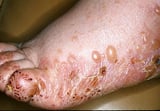Which Of The Following Is Responsible For Skin Pigmentation?
Hyperpigmentation is darkening of skin, nigh often caused past an abnormally high amount of the skin pigment melanin.
Localized hyperpigmentation can be caused by
-
Skin injuries
-
Skin inflammation
-
Reactions to sunlight
-
Aberrant peel growths
Hyperpigmentation can likewise occur in melasma Melasma Melasma is dark brown patches of pigmentation that announced on sun-exposed areas of the skin, normally the face. Patchy areas of dark color appear on the skin. Doctors usually base the diagnosis... read more than  , freckles Lentigines Hyperpigmentation is concealment of skin, near oft caused by an abnormally high amount of the pare pigment melanin. When exposed to sunlight, specialized pare cells called melanocytes (see Overview... read more
, freckles Lentigines Hyperpigmentation is concealment of skin, near oft caused by an abnormally high amount of the pare pigment melanin. When exposed to sunlight, specialized pare cells called melanocytes (see Overview... read more  , lentigines Lentigines Hyperpigmentation is darkening of skin, about oftentimes caused by an abnormally loftier corporeality of the skin paint melanin. When exposed to sunlight, specialized skin cells called melanocytes (run across Overview... read more
, lentigines Lentigines Hyperpigmentation is darkening of skin, about oftentimes caused by an abnormally loftier corporeality of the skin paint melanin. When exposed to sunlight, specialized skin cells called melanocytes (run across Overview... read more  , and café-au-lait spots (flat, brown spots), as well as in abnormal peel growths such as melanoma Melanoma Melanoma is a peel cancer that begins in the paint-producing cells of the pare (melanocytes). Melanomas can begin on normal skin or in existing moles. They may be irregular, flat or raised... read more than
, and café-au-lait spots (flat, brown spots), as well as in abnormal peel growths such as melanoma Melanoma Melanoma is a peel cancer that begins in the paint-producing cells of the pare (melanocytes). Melanomas can begin on normal skin or in existing moles. They may be irregular, flat or raised... read more than  .
.
People who have a disorder called acanthosis nigricans develop darkened and thickened skin in the underarms, on the nape of the neck, and in skinfolds. Acanthosis nigricans can exist a symptom of diabetes.
Lentigines (commonly called age spots or liver spots [but are non related to liver problems]) are flat, tan to brownish, oval spots on the peel. A unmarried spot is called a lentigo. They are a type of localized hyperpigmentation.
There are 2 types:
-
Solar
-
Nonsolar
Solar lentigines are acquired by sunday exposure and are the well-nigh common type of lentigo. They occur most frequently on areas that are exposed to the sun, such as the face and dorsum of the hands. They typically first announced during middle historic period and increase in number as people age. Lentigines are noncancerous (beneficial), simply people who have them may exist at higher chance of melanoma.
Nonsolar lentigines are not caused by sun exposure. Nonsolar lentigines sometimes occur in people with sure rare hereditary disorders, such equally Peutz-Jeghers syndrome Hereditary weather that cause intestinal polyps  (characterized past many lentigines on the lips and polyps in the stomach and intestine), xeroderma pigmentosum, and multiple lentigines syndrome (LEOPARD syndrome).
(characterized past many lentigines on the lips and polyps in the stomach and intestine), xeroderma pigmentosum, and multiple lentigines syndrome (LEOPARD syndrome).
If people do not have as well many lentigines, doctors can remove them with freezing treatments (cryotherapy) or laser therapy. Bleaching agents such as hydroquinone are non constructive.
Widespread hyperpigmentation tin be caused by
-
Changes in hormones
-
Internal diseases
-
Drugs and heavy metals
Hormonal changes may increase melanin product and darken the skin in Addison disease Addison Illness In Addison disease, the adrenal glands are underactive, resulting in a deficiency of adrenal hormones. Addison disease may be caused by an autoimmune reaction, cancer, an infection, or some... read more  , in pregnancy, or with hormonal contraceptive use. A liver disorder called primary biliary cholangitis Primary Biliary Cholangitis (PBC) Primary biliary cholangitis (PBC) is inflammation with progressive scarring of the bile ducts in the liver. Eventually, the ducts are blocked, the liver becomes scarred, and cirrhosis and liver... read more (previously called primary biliary cirrhosis) may also cause increased melanin product.
, in pregnancy, or with hormonal contraceptive use. A liver disorder called primary biliary cholangitis Primary Biliary Cholangitis (PBC) Primary biliary cholangitis (PBC) is inflammation with progressive scarring of the bile ducts in the liver. Eventually, the ducts are blocked, the liver becomes scarred, and cirrhosis and liver... read more (previously called primary biliary cirrhosis) may also cause increased melanin product.
Drugs and heavy metals that can cause hyperpigmentation include the following:
-
Amiodarone
-
Hydroquinone
-
Antimalarial drugs
-
Tetracycline antibiotics
-
Phenothiazines
-
Some cancer chemotherapy drugs
-
Some tricyclic antidepressants
-
Some heavy metals (such as silver, golden, and mercury, which can be poisonous)
The areas of hyperpigmentation are usually widespread, but some drugs tin can specifically affect certain areas. For example, some people develop stock-still drug reactions, in which sure drugs (for example, certain antibiotics, nonsteroidal anti-inflammatory drugs [NSAIDs], and barbiturates) cause red patches or blisters to grade in the same place on the skin every time the drug is taken. These reactions somewhen lead to hyperpigmentation of the affected skin.
Depending on the drug or metal and where information technology is full-bodied in the skin, hyperpigmentation may be violet, bluish black, yellow-brown, or shades of bluish, silver, and greyness (see also Color Changes in the Peel Colour Changes in the Skin Doctors use specific terms to describe various types of marks and growths on the skin. Some skin disorders and infections can cause color changes in the skin. (See also Structure and Part... read more  ). In addition to the peel, the teeth, nails, white of the eyes (sclera), and lining of the mouth (mucosa) may be discolored. With many of these drugs, the hyperpigmentation often fades afterwards the drug is stopped, just information technology tin can take longer to fade in people who have darker skin. Sometimes the hyperpigmentation is permanent regardless of pare colour.
). In addition to the peel, the teeth, nails, white of the eyes (sclera), and lining of the mouth (mucosa) may be discolored. With many of these drugs, the hyperpigmentation often fades afterwards the drug is stopped, just information technology tin can take longer to fade in people who have darker skin. Sometimes the hyperpigmentation is permanent regardless of pare colour.
CLICK HERE FOR THE PROFESSIONAL VERSION

© 2022 Merck & Co., Inc., Rahway, NJ, U.s. and its affiliates. All rights reserved.
Source: https://www.msdmanuals.com/home/skin-disorders/pigment-disorders/hyperpigmentation
Posted by: caudlefreat1966.blogspot.com

0 Response to "Which Of The Following Is Responsible For Skin Pigmentation?"
Post a Comment